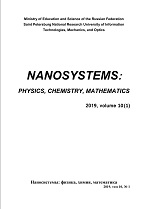|
Эта публикация цитируется в 2 научных статьях (всего в 2 статьях)
PHYSICS
Hund's rule in open-shell states of two-electron systems: from free through confined and screened atoms, to quantum dots
Jacob Katriela, H. E. Montgomery, Jr.b, A. Sarsac, E. Buendíad, F. J. Gálvezd, K. D. Sene
a Department of Chemistry, Technion – Israel Institute of Technology, Haifa, 32000 Israel
b Chemistry Program, Centre College, Danville, Kentucky 40422, USA
c Departamento de Física, Campus de Rabanales Edif. C2,
Universidad de Cordoba, E-14071 Córdoba, Spain
d Departamento de Física Atómica, Molecular y Nuclear, Facultad de Ciencias, Universidad de Granada, E-18071 Granada, Spain
e School of Chemistry, University of Hyderabad, Hyderabad-500 046, India
Аннотация:
Singly-excited singlet-triplet pairs of states of two-electron spherically symmetric systems, that are degenerate in the absence of inter-electronic repulsion, are revisited. In addition to the obvious two-electron atom we consider the two-electron quantum dot confined by either a harmonic potential or by an infinite spherical well, the confined two-electron atom, and three variants of an atom immersed in a plasma, modeled by the screened Coulomb (Debye) potential. The validity of Hund’s multiplicity rule is confirmed, and the contribution of the interparticle repulsion energy to the singlet-triplet splitting is examined. One feature that all these systems share is that the triplet wave function is contracted relative to that of the corresponding singlet. This feature, which is a consequence of the virial theorem, affects both the behavior of the outer electron ionization energies and the relative magnitudes of the inter-particle repulsion energies in the singlet vs. the triplet. Whereas in atomic highly positive ions the interelectronic repulsion is lower in the triplet than in the corresponding singlet state, this ordering is reversed in neutral atoms. Such reversal does not take place in quantum dots. Confined and screened systems exhibit more nuanced behavior. The analysis utilizes appropriate variants of the virial and Hellmann-Feynman theorems.
Ключевые слова:
two-electron quantum dots, confined two-electron atom, screened coulomb potential, Hund’s multiplicity rule, Virial theorem, Hellmann-Feynman theorem.
Поступила в редакцию: 25.01.2019
Исправленный вариант: 19.02.2019
Образец цитирования:
Jacob Katriel, H. E. Montgomery, Jr., A. Sarsa, E. Buendía, F. J. Gálvez, K. D. Sen, “Hund's rule in open-shell states of two-electron systems: from free through confined and screened atoms, to quantum dots”, Наносистемы: физика, химия, математика, 10:1 (2019), 31–41
Образцы ссылок на эту страницу:
https://www.mathnet.ru/rus/nano413 https://www.mathnet.ru/rus/nano/v10/i1/p31
|

| Статистика просмотров: |
| Страница аннотации: | 116 | | PDF полного текста: | 59 |
|



 Обратная связь:
Обратная связь: Пользовательское соглашение
Пользовательское соглашение
 Регистрация посетителей портала
Регистрация посетителей портала Логотипы
Логотипы